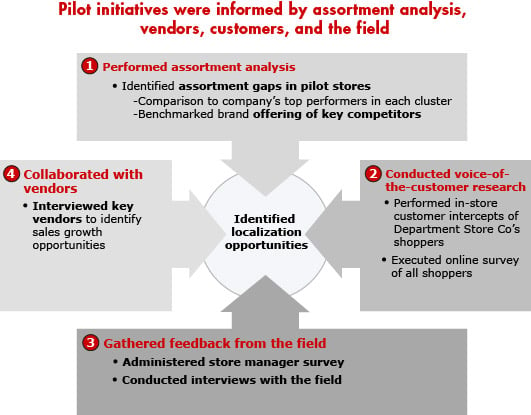The Situation
A leading department store chain, with hundreds of outlets, had pinned its growth strategy on a cookie-cutter approach, stocking similar products nationwide despite a huge range in store sizes, layouts and customer demographics.
Department StoreCo's* strategy was straightforward: After acquiring other retail chains, it wanted to grow revenues and maximize efficiencies by taking full advantage of its scale.
It wasn't a new strategy. Many giant retailers have built their success with a chain of identical stores. But times were changing; shoppers wanted more customized merchandise.
This trend was reflected in Department StoreCo's slumping sales. As pressure intensified, the CEO needed to find a way to rejuvenate sales.
Our Approach
Working with the CEO, we helped transform the retailer's growth strategy. Our research shows that tailoring product assortments to local tastes can boost same-store sales by 1 to 3 percentage points, and only 10 percent to 15 percent of the inventory needs to be customized.
Together with senior management, we designed a pilot project to identify localization opportunities. The process involved four steps:
- Perform an assortment analysis to find inventory gaps in pilot stores.
- Collaborate with vendors to spot sales growth opportunities.
- Conduct customer research to learn about their preferences and needs.
- Gather management feedback from regional and local store managers about assortment decision-making.

Our Recommendations
Based on our assortment analysis and feedback from vendors, customers and store managers, we recommended that the company launch localization pilots in a range of stores, varying in size, location and customer demographics.
The database we developed and information from managers would allow the retailer to offer merchandise, geared to customers' different lifestyles and budgets. To succeed, the retailer needed to launch the pilot in stores with the largest growth opportunities and make some key changes:
- Decentralize decision-making and empower managers to select more products based on local demand.
- Develop sophisticated systems and capabilities to coordinate a localized production selection process.
- Lead an organization-wide management change initiative to support the new localized strategy.
The Results
The pilot store initiative we collaboratively developed quickly demonstrated success, proving the power of tailoring merchandise to shoppers' tastes and pocket books:
- Higher sales: Pilot stores quickly racked up increased sales. In just the first quarter of 2009, pilot stores achieved growth that was 2.1 percent higher than in all of the retailers' other stores.
- Stronger competitor: By empowering managers close to customers, the retailer could quickly respond to market shifts, making it a more nimble competitor.
Most of the pilot stores were located in top performing regions. Even so, Department StoreCo was surprised when the pilot project debunked one its practices—offering limited product assortments in smaller stores. Some of the biggest sales increases were in small pilot stores with wealthier customers who were willing to buy more expensive fashions—if they were on the racks.
* We take our clients' confidentiality seriously. While we've changed their names, the results are real.
